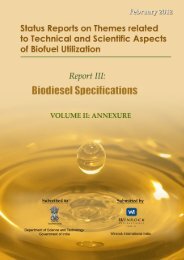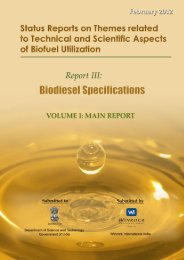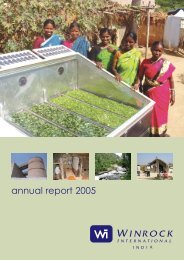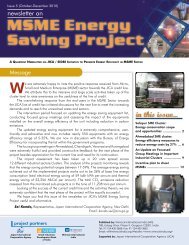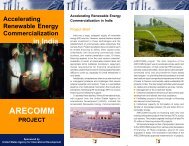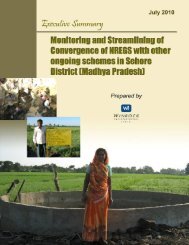IssuE 8 â ApRIl â JuNE 2011 - Winrock International India
IssuE 8 â ApRIl â JuNE 2011 - Winrock International India
IssuE 8 â ApRIl â JuNE 2011 - Winrock International India
Create successful ePaper yourself
Turn your PDF publications into a flip-book with our unique Google optimized e-Paper software.
Case Study<br />
The IIPs are either firm or continuous<br />
power producers. Both use bagasse<br />
as the input fuel during the crop<br />
season, however, firm producers<br />
generated electricity all year round<br />
by using coal when bagasse is<br />
unavailable. Table 2 shows names of<br />
IIPs in Mauritius.<br />
The BEDP program coupled with the<br />
shift to more easily available imported<br />
coal has been successful and this can<br />
be gauged by studying the statistics for<br />
electricity production by source. For<br />
e.g. the share of fuel oil for generating<br />
electricity reduced by nearly 20% (from<br />
58% to 35%) over a span of 10 years<br />
from 1994 to 2003. During this period,<br />
the use of coal to generate electricity<br />
experienced an increase of 24%. As of<br />
2010, the share of coal is the largest<br />
at about 60% with bagasse and fuel<br />
contributing nearly the same share.<br />
Looking ahead<br />
In October 2009, the government<br />
of Mauritius elaborated the Long<br />
Term Energy Strategy and Action<br />
Plan. The plan lays emphasis on the<br />
development of renewable energy,<br />
reducing dependence on imported<br />
fossil fuel and the promotion of energy<br />
efficiency. This is in line with the<br />
Government’s objective to promote<br />
sustainable development in the context<br />
of the Maurice Ile Durable vision.<br />
Specifically for bagasse energy, the<br />
Master Plan for Renewable Energy<br />
has certain clear objectives. These<br />
objectives are enumerated below:<br />
Table 2: IIPs in Mauritius<br />
Firm Producers<br />
F.U.E.L.<br />
Compagnie thermique de Belle Vue<br />
Consolidated energy limited<br />
Compagnie thermique du Sud<br />
Compagnie thermique de Savannah<br />
GWh<br />
2750<br />
2500<br />
2250<br />
2000<br />
1750<br />
1500<br />
1250<br />
1000<br />
750<br />
500<br />
250<br />
0<br />
2000 2001 2002 2003 2004 2005 2006 2007 2008 2009 Mauritius is committed<br />
Electricity production by source of energy, 2000 - 2009 to progressing towards a<br />
sustainable energy pathway.<br />
°° Use bagasse more efficiently with a<br />
view to increasing the contribution<br />
of bagasse based electricity in the<br />
medium-term from the present<br />
level of 350 GWh to 600 GWh<br />
annually.<br />
°° Additional electricity from the<br />
same amount of bagasse currently<br />
available from the 5 millions tons<br />
of cane can be generated by the<br />
sugar industry through investment<br />
in power plants operating at higher<br />
pressure.<br />
The country has judiciously utilized<br />
an abundant natural resource. In terms<br />
of environmental benefit, one of the<br />
positive aspects of using bagasse is<br />
its low ash content as compared to<br />
coal. However, Mauritius needs to<br />
be mindful of the fact that excessive<br />
sugarcane plantation could be harmful<br />
to soil fertility and may have negative<br />
impacts on yield and soil. Nonetheless,<br />
other countries should take inspiration<br />
from this island nation and diversify<br />
their energy mix.<br />
°° Benefits from the use of additional<br />
bagasse be reaped by all<br />
stakeholders of the sugar industry<br />
to IPP’s. Accruals from CER’s to be<br />
passed on to the CEB.<br />
°° Maximize the amount of energy<br />
generated from available bagasse,<br />
while minimizing the use of coal.<br />
Within this framework, achieve<br />
the target of 600 GWh of electricity<br />
from bagasse in medium term.<br />
°° Promote research and development<br />
in the sector to develop new<br />
varieties of sugar cane with higher<br />
biomass production.<br />
References and Further<br />
Reading<br />
°° http://en.wikipedia.org/wiki/<br />
Mauritius<br />
°° Outline Energy Policy 2007-2025,<br />
Government of Mauritius<br />
°° Digest of Energy and Water<br />
Statistics – 2009, Central Statistics<br />
Organization, Government of<br />
Mauritius<br />
°° Hassen, Sayed S.Z. and Bhurtan,<br />
C., Trends in the Power Sector in<br />
Mauritius, Department of Electrical<br />
and Electronic Engineering,<br />
University of Mauritius<br />
°° Digest of Agricultural Statistics<br />
Continuous Producers<br />
2009, Central Statistics Organization,<br />
Medine<br />
Government of Mauritius<br />
Union St. Aubin<br />
Mon Loisir<br />
Diesel & Fuel oil<br />
Bagasse<br />
Coal<br />
Kerosene<br />
Hydro<br />
°° Encourage the use of<br />
new varieties of sugar<br />
cane with higher biomass<br />
content and any other<br />
technology that would<br />
be commercialized so as<br />
to increase the amount of<br />
energy generated from<br />
bagasse.<br />
Courtesy: Dinesh Kapur<br />
CLC Division,<strong>Winrock</strong> <strong>International</strong> <strong>India</strong><br />
Email: dinesh@winrockindia.org<br />
April-June <strong>2011</strong><br />
35




